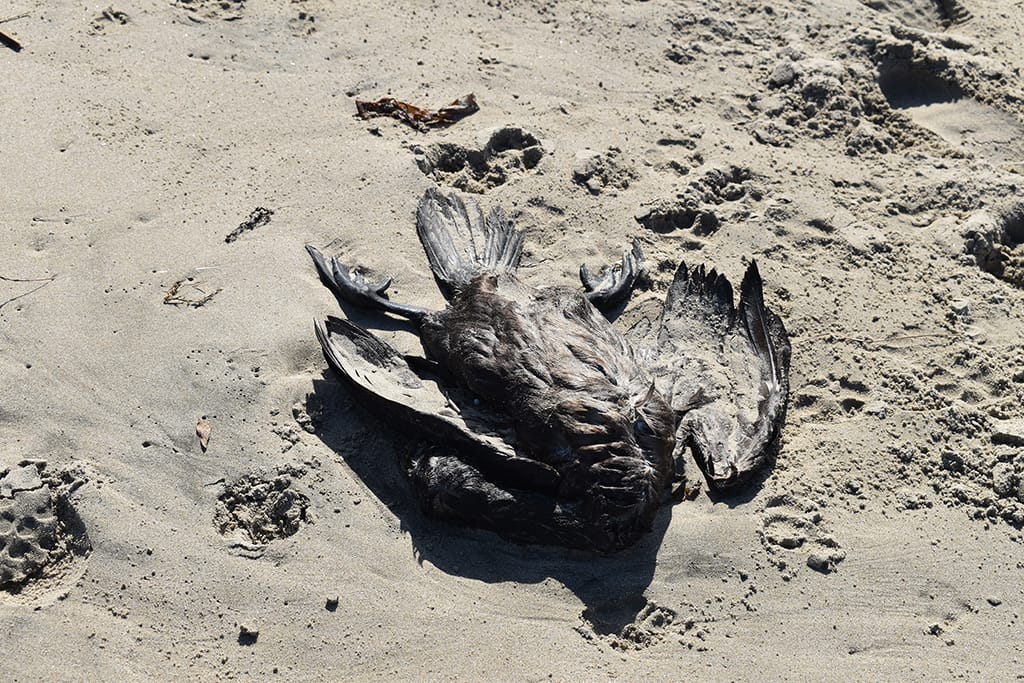If you’ve walked along the sand on Venice Beach this week, you may have come across the body of a dead cormorant.
Santa Monica nonprofit Heal the Bay confirmed it had received reports of several dead sea birds on the sand in the area around Venice Boulevard that came in on Tuesday evening, Jan. 25, and Wednesday morning, Jan. 26. But the environmental advocacy group was not able to confirm how many birds were found or how the animals may have died.
“Heal the Bay doesn’t have the capacity or expertise to respond to an incident like this,” water quality scientist Luke Ginger said Wednesday. “So, we immediately notified people to reach out to the International Bird Rescue, which is a nonprofit that does work locally and does respond to incidents like these.”
After being sent photos and videos of the dead birds via social media, Heal the Bay representatives identified them as cormorants. By Wednesday at midday, the bodies of two dead sea birds that appeared to be cormorants remained on the sand, right around the high tide line. Ginger said International Bird Rescue or the LA County Fish and Wildlife Commission — an office under the LA County Supervisors — may have collected specimens to perform a necropsy. Scavengers and high tides may have washed others away.
Russ Curtis, a spokesperson for International Bird Rescue, said the group focuses mostly on rescuing and rehabilitating distressed or injured birds and, though it had also been made aware of the incident, it was more likely LA County Fish and Wildlife Commission would be launching an investigation.
LA County Fish and Wildlife did not respond to an interview request by Daily Press deadline.
Both Ginger and Curtis said the best thing to do if you come across a dead or distressed marine animal is to call a local rescue or animal control center.
“What we recommend the public to do is what they did in this instance, which is they took photos, took notice of where this incident occurred, and they left the birds in place, which is the proper procedure,” Ginger said. “There are some times where we get photos or reports that are very vague, when what we really need is the context, in order to properly direct people where to go. So we thought that was great.”
The same is true for other calls, such as marine mammals or certain types of pollution on beaches, Ginger added.
Curtis said that, in some instances, it’s OK for people to pick up birds in distress and take them into rescue centers. He mentioned birds that may be tangled in fishing line and begin to experience high levels of stress.
“If you feel comfortable enough to bring a towel and a box and gently wrap the bird up so it doesn’t get anymore stressed and put it into a box and get it to us quickly, we’re OK with that,” Curtis said. However, some birds may be dangerous — with pecks and scratches a bigger worry than avian-borne illnesses.
“We’ve had people that have been injured — even our volunteers — and so we always tell people to be careful around wild animals,” Curtis added.
Curtis said he believed the birds to be Brandt’s cormorants, a subspecies common along the Pacific Coast.
“Sociable at all seasons, it is often seen flying in long lines low over the water. Groups roost together on rocks near water, and feed in flocks offshore, often associating with other seabirds,” according to the Audubon Society website. Representatives for the Santa Monica Audubon Society were not available for comment by Daily Press deadline.
Curtis said cormorants were diving birds, often recognizable on rocks and jetties drying their wings which, interestingly, are not waterproof.
And, although to the common beachgoer it could appear that cormorants and gulls share similar behavior and territory, their differences in feeding style and habitat could mean an ailment or hazard that affects cormorants could have no effect on other sea birds, which could be seen in droves along the beach at midday on Wednesday.
“It appears that the only dead birds that we know of [on Venice Beach] are cormorants and that could be attributed to differences between the birds — it could be like what type of foods they’re going after, it could also be linked to their behavior,” Ginger said. “So, cormorants are going to be spending more time in the water, less air, vs seagulls, and they’re going to be congregating in different areas. So, you know, without knowing a cause, we really can’t say what difference there is. But these different pieces of hers are behaving very differently, even though they’re out on the beach.”
If you come across a distressed marine bird, contact the International Bird Rescue at 310.514.2573 from 8 a.m. to 5 p.m., or call 866.WILD.911. For marine mammals, contact Marine Animal Rescue at 800.39.WHALE.
As for marine mammals, Ginger said: “We recommend not touching the animal or trying to return it to the water if you know it’s the kind of animal that needs to be in the water. We do not recommend pouring water on the animal or moving it in any way. We recommend folks to keep their distance and call the appropriate rescue hotline and take a picture and note down details.”
Other agencies to notify include California Wildlife Center, LA County Fish and Wildlife Commission and Heal the Bay.
emily@smdp.com


